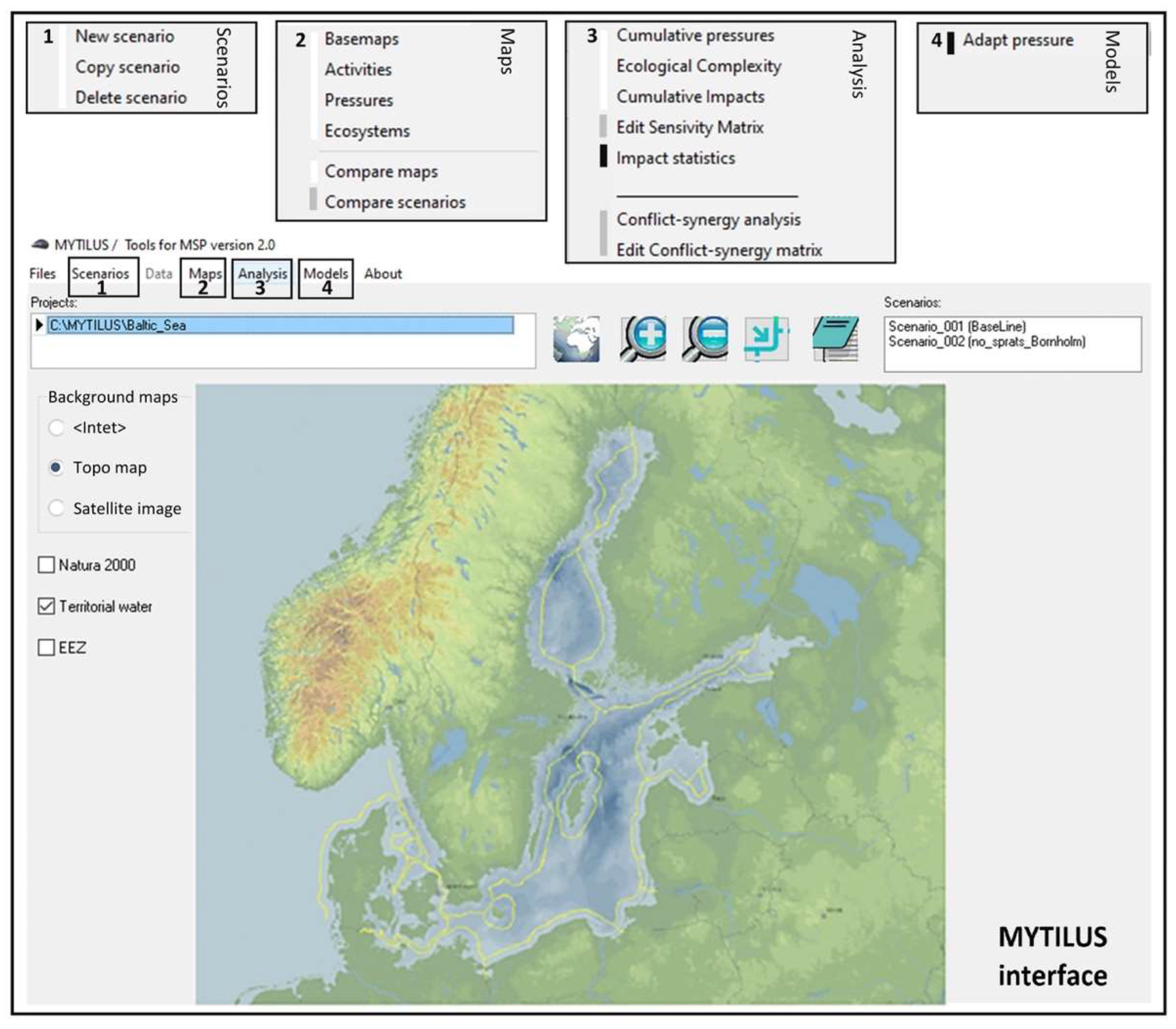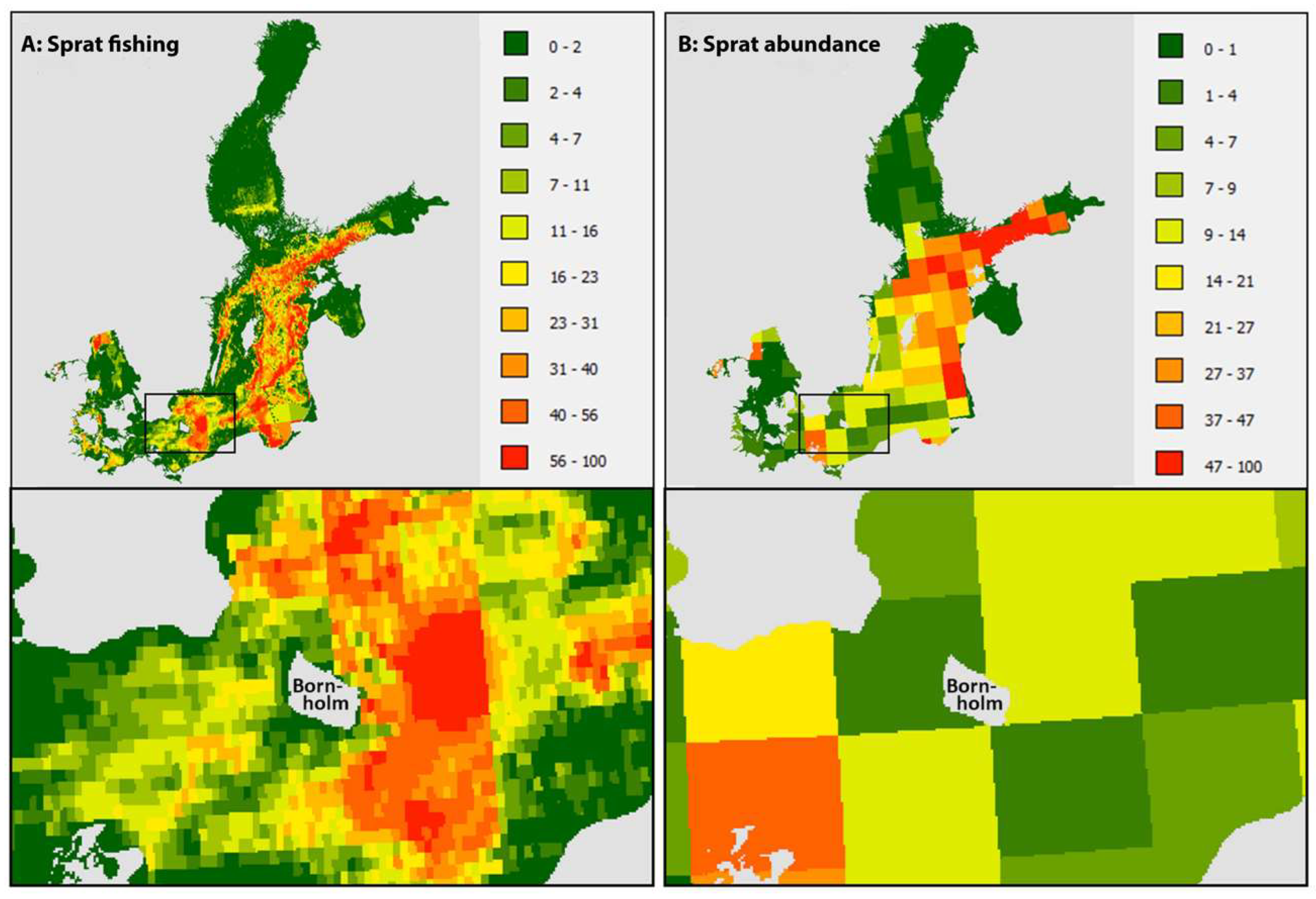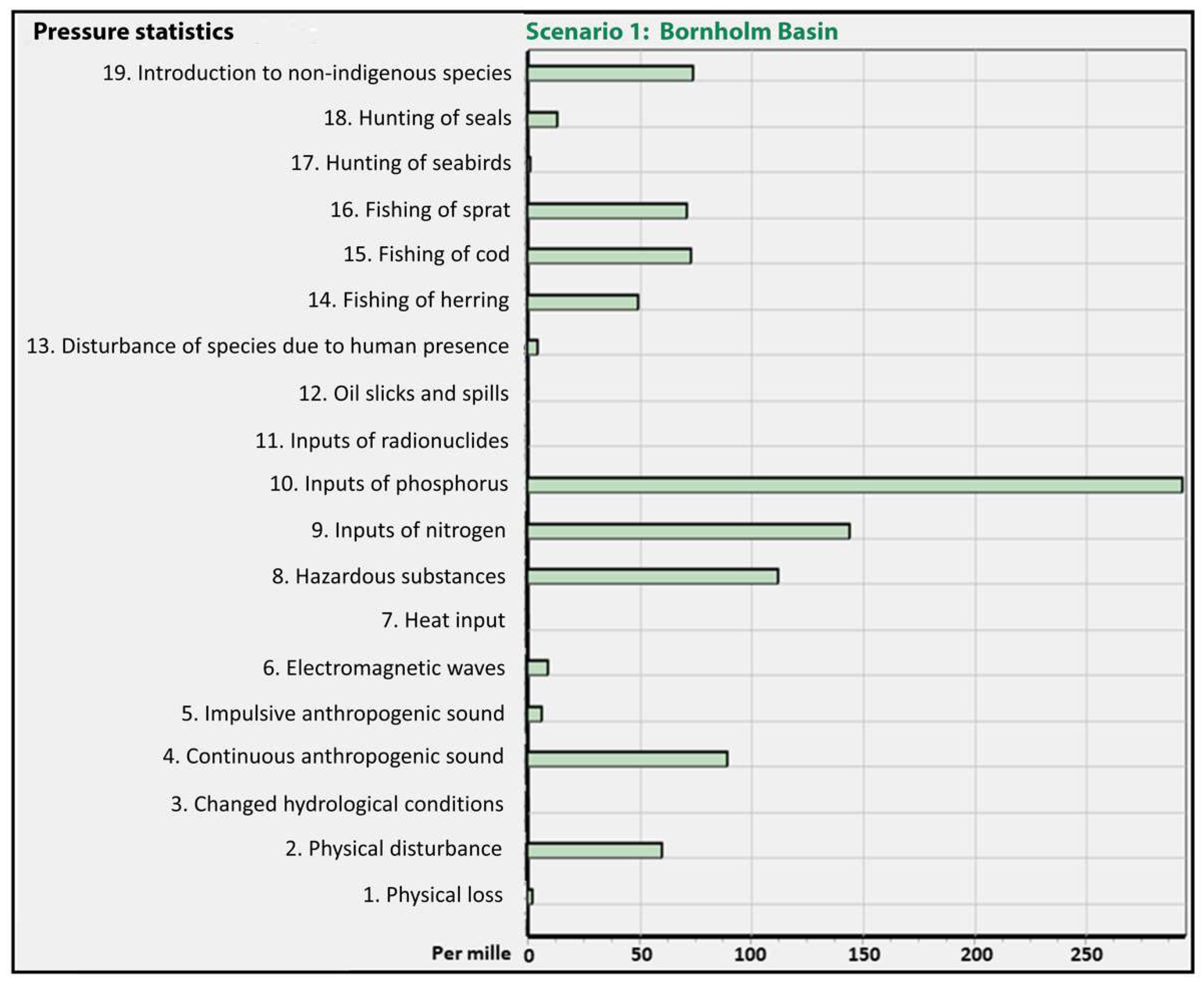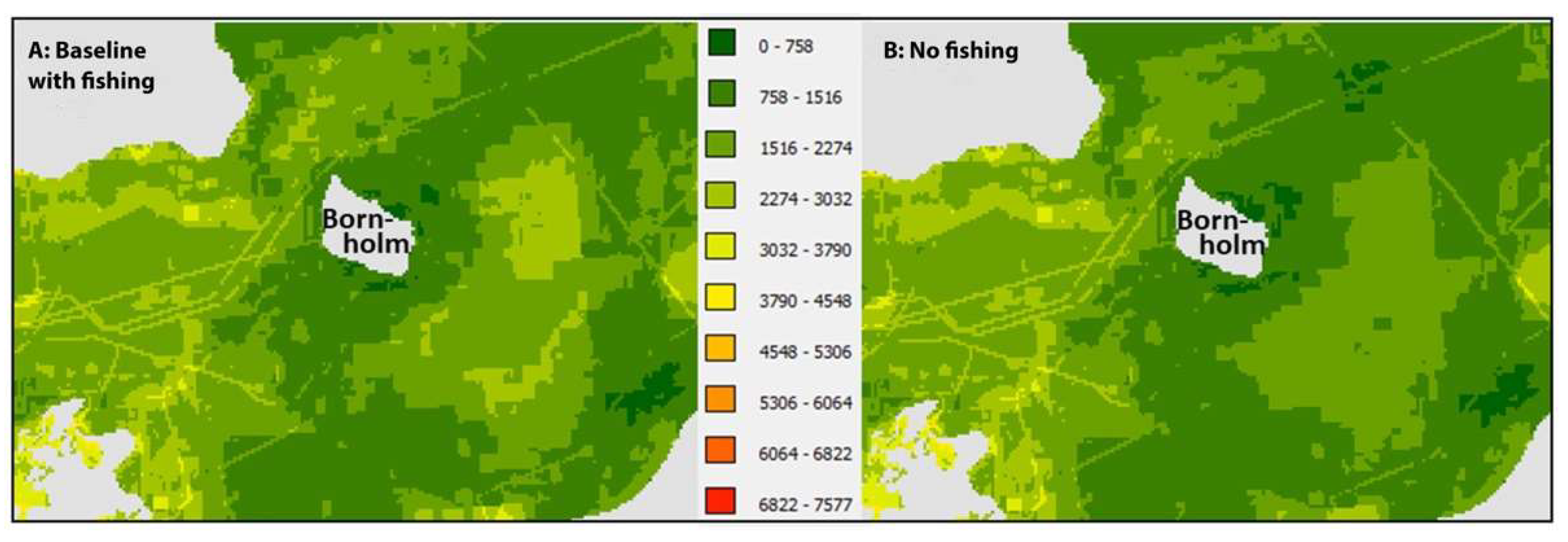Utilising MYTILUS for Active Learning to Compare Cumulative Impacts on the Marine Environment in Different Planning Scenarios
Abstract
1. Introduction
2. Materials and Methods
2.1. MYTILUS and Its Newest Improvements
2.2. Current Data and Data Requirements
2.3. Development of the Training Set
3. Results
3.1. Maps and Data
3.2. Impacts
3.3. Alternative Scenario
3.4. Use–Use Interactions
4. Discussion of Strengths and Weaknesses
4.1. Expressed Strengths of MYTILUS—Related to the Training Design
4.2. Expressed Challenges of MYTILUS—Related to the Training Design
5. Conclusions
- Make strong use of visuals such as maps and statistics, make use of fast calculations, and amplify user-friendly aspects of the tool interface;
- Consider the learning flow where inputs are explored before spatial outputs, and spatial outputs are linked to more detailed sub-statistics, and where the tasks build on top of each other in a systematic way;
- Combine multiple tool approaches to support an integrative tool setup;
- Enable time and technical setups for engaging with the material alone and as part of cross-student online discussions, especially for complicated tasks, to enable students to actively find strengths and limitations of the approaches and data;
- Allow for user inputs to the data and for students to link the material to their own research.
Author Contributions
Funding
Institutional Review Board Statement
Informed Consent Statement
Data Availability Statement
Acknowledgments
Conflicts of Interest
References
- Santos, C.F.; Agardy, T.; Andrade, F.; Calado, H.; Crowder, L.B.; Ehler, C.N.; García-Morales, S.; Gissi, E.; Halpern, B.S.; Orbach, M.K.; et al. Integrating climate change in ocean planning. Nat. Sustain. 2020, 3, 505–516. [Google Scholar] [CrossRef]
- Kyriazi, Z. From identification of compatibilities and conflicts to reaching marine spatial allocation agreements. Review of actions required and relevant tools and processes. Ocean. Coast. Manag. 2018, 166, 103–112. [Google Scholar] [CrossRef]
- Ntona, M.; Morgera, E. Connecting SDG 14 with the other Sustainable Development Goals through marine spatial planning. Mar. Policy 2018, 93, 214–222. [Google Scholar] [CrossRef]
- Santos, C.F.; Agardy, T.; Andrade, F.; Crowder, L.B.; Ehler, C.N.; Orbach, M.K. Major challenges in developing marine spatial planning. Mar. Policy 2021, 132, 103248. [Google Scholar] [CrossRef]
- Moodie, J.R.; Kull, M.; Morf, A.; Schrøder, L.; Giacometti, A. Challenges and enablers for transboundary integration in MSP: Practical experiences from the Baltic Scope project. Ocean. Coast. Manag. 2019, 177, 1–21. [Google Scholar] [CrossRef]
- Ehler, C.; Douvere, F. Marine Spatial Planning: A step-by-step approach toward ecosystem-based management. In Intergovernmental Oceanographic Commission and Man and the Biosphere Programme; IOC Manual and Guides; UNESCO: Paris, France, 2009; pp. 1–99. [Google Scholar]
- EC. Directive 2014/89/EU Establishing a framework for maritime spatial planning. 2014. Available online: https://eur-lex.europa.eu/legal-content/EN/TXT/PDF/?uri=OJ:L:2014:257:FULL&from=PT (accessed on 23 August 2022).
- EC. Directive 2008/56/EU Establishing a framework for community action in the field of marine environmental policy (Marine Strategy Framework Directive). 2008. Available online: https://eur-lex.europa.eu/legal-content/EN/TXT/?uri=celex%3A32008L0056 (accessed on 23 August 2022).
- Jay, S.; Alves, F.L.; O’Mahony, C.; Gomez, M.; Rooney, A.; Almodovar, M.; Gee, K.; de Vivero, J.L.S.; Gonçalves, J.M.S.; Fernandes, M.d.L.; et al. Transboundary dimensions of marine spatial planning: Fostering inter-jurisdictional relations and governance. Mar. Policy 2016, 65, 85–96. [Google Scholar] [CrossRef]
- Hassler, B.; Blažauskas, N.; Gee, K.; Luttmann, A.; Morf, A.; Piwowarczyk, J.; Saunders, F.; Stalmokaitė, I.; Strand, H.; Zaucha, J. New generation EU directives, sustainability, and the role of transnational coordination in Baltic Sea maritime spatial planning. Ocean. Coast. Manag. 2019, 169, 254–263. [Google Scholar] [CrossRef]
- Borja, A.; Elliott, M.; Andersen, J.H.; Berg, T.; Carstensen, J.; Halpern, B.S.; Heiskanen, A.-S.; Korpinen, S.; Lowndes, J.S.S.; Martin, G.; et al. Overview of Integrative Assessment of Marine Systems: The Ecosystem Approach in Practice. Front. Mar. Sci. 2016, 3. [Google Scholar] [CrossRef]
- Morf, A.; Moodie, J.; Gee, K.; Giacometti, A.; Kull, M.; Piwowarczyk, J.; Schiele, K.; Zaucha, J.; Kellecioglu, I.; Luttmann, A.; et al. Towards sustainability of marine governance: Challenges and enablers for stakeholder integration in trans-boundary marine spatial planning in the Baltic Sea. Ocean. Coast. Manag. 2019, 177, 200–212. [Google Scholar] [CrossRef]
- Saunders, P.F.; Gilek, M.; Tafon, R. Adding People to the Sea: Conceptualizing Social Sustainability in Maritime Spatial Planning. In Maritime Spatial Planning: Past, Present, Future; Zaucha, J., Gee, K., Eds.; Palgrave McMillan: London, UK, 2019. [Google Scholar]
- Gee, K.; Kannen, A.; Adlam, R.; Brooks, C.; Chapman, M.; Cormier, R.; Fischer, C.; Fletcher, S.; Gubbins, M.; Shucksmith, R.; et al. Identifying culturally significant areas for marine spatial planning. Ocean. Coast. Manag. 2017, 136, 139–147. [Google Scholar] [CrossRef]
- Pınarbaşı, K.; Galparsoro, I.; Borja, Á.; Stelzenmüller, V.; Ehler, C.N.; Gimpel, A. Decision support tools in marine spatial planning: Present applications, gaps and future perspectives. Mar. Policy 2017, 83, 83–91. [Google Scholar] [CrossRef]
- Koski, C.; Rönneberg, M.; Kettunen, P.; Armoškaitė, A.; Strake, S.; Oksanen, J. User experiences of using a spatial analysis tool in collaborative GIS for maritime spatial planning. Trans. GIS 2021, 25, 1809–1824. [Google Scholar] [CrossRef]
- Schumacher, J.; Bergqvist, L.; van Beest, F.M.; Carstensen, J.; Gustafsson, B.; Hasler, B.; Fleming, V.; Nygård, H.; Pakalniete, K.; Sokolov, A.; et al. Bridging the Science-Policy Gap—Toward Better Integration of Decision Support Tools in Coastal and Marine Policy Implementation. Front. Mar. Sci. 2020, 7, 587500. [Google Scholar] [CrossRef]
- Stock, A. Open source software for mapping human impacts on marine ecosystems with an additive model. J. Open Res. Softw. 2016, 4, 1–7. [Google Scholar] [CrossRef]
- Menegon, S.; Depellegrin, D.; Farella, G.; Sarretta, A.; Venier, C.; Barbanti, A. Addressing cumulative effects, maritime conflicts and ecosystem services threats through MSP-oriented geospatial webtools. Ocean. Coast. Manag. 2018, 163, 417–436. [Google Scholar] [CrossRef]
- Hammar, L.; Molander, S.; Pålsson, J.; Crona, J.S.; Carneiro, G.; Johansson, T.; Hume, D.; Kågesten, G.; Mattson, D.; Törnqvist, O.; et al. Cumulative impact assessment for ecosystem-based marine spatial planning. Sci. Total Environ. 2020, 734, 139024. [Google Scholar] [CrossRef]
- Hansen, H.S. Cumulative impact of societal activities on marine ecosystems and their services. Lect. Notes Comput. Sci. LNCS 2019, 11621, 577–590. [Google Scholar] [CrossRef]
- Watts, M.E.; Ball, I.R.; Stewart, R.S.; Klein, C.J.; Wilson, K.; Steinback, C.; Lourival, R.; Kircher, L.; Possingham, H.P. Marxan with Zones: Software for optimal conservation based land- and sea-use zoning. Environ. Model. Softw. 2009, 24, 1513–1521. [Google Scholar] [CrossRef]
- Depellegrin, D.; Hansen, H.S.; Schrøder, L.; Bergström, L.; Romagnoni, G.; Steenbeek, J.; Gonçalves, M.; Carneiro, G.; Hammar, L.; Pålsson, J.; et al. Current status, advancements and development needs of geospatial decision support tools for marine spatial planning in European seas. Ocean. Coast. Manag. 2021, 209, 105644. [Google Scholar] [CrossRef]
- Halpern, B.S.; Walbridge, S.; Selkoe, K.A.; Kappel, C.V.; Micheli, F.; D’Agrosa, C.; Bruno, J.F.; Casey, K.S.; Ebert, C.; Fox, H.E.; et al. A global map of human impact on marine ecosystems. Science 2008, 319, 948–952. [Google Scholar] [CrossRef]
- Hansen, H.S.; Bonnevie, I.M. A toolset to estimate the effects of human activities in maritime spatial planning. Lect. Notes Comput. Sci. LNCS 2020, 12252, 521–534. [Google Scholar] [CrossRef]
- Klinger, D.H.; Eikeset, A.M.; Davíðsdóttir, B.; Winter, A.; Watson, J.R. The mechanics of blue growth: Management of oceanic natural resource use with multiple, interacting sectors. Mar. Policy 2018, 87, 356–362. [Google Scholar] [CrossRef]
- HELCOM. The Assessment of Cumulative Impacts Using the BSPI [Baltic Sea Pressure Index] and the BSII [Baltic Sea Impact Index]—Supplementary Report to the First Version of the HELCOM ‘State of the Baltic Sea’ Report. 2017. Available online: https://stateofthebalticsea.helcom.fi/about-helcom-and-the-assessment/downloads-and-data/ (accessed on 9 August 2022).
- Collie, J.S.; Adamowicz, W.L.V.; Beck, M.W.; Craig, B.; Essington, T.E.; Fluharty, D.; Rice, J.; Sanchirico, J.N. Marine spatial planning in practice. Estuar. Coast. Shelf Sci. 2013, 117, 1–11. [Google Scholar] [CrossRef]
- Bonnevie, I.M.; Hansen, H.S.; Schrøder, L. SEANERGY—A spatial tool to facilitate the increase of synergies and to minimise conflicts between human uses at sea. Environ. Model. Softw. 2020, 132, 104808. [Google Scholar] [CrossRef]
- Servant-Miklos, V. Problem-oriented Project Work and Problem-based Learning: “Mind the gap!”. Interdiscip. J. Probl.-Based Learn. 2020, 14. [Google Scholar] [CrossRef]
- Stanny, C.J. Reevaluating Bloom’s Taxonomy: What Measurable Verbs Can and Cannot Say about Student Learning. Educ. Sci. 2016, 6, 37. [Google Scholar] [CrossRef]
- Schupp, M.F.; Bocci, M.; Depellegrin, D.; Kafas, A.; Kyriazi, Z.; Lukic, I.; Schultz-Zehden, A.; Krause, G.; Onyango, V.; Buck, B.H. Toward a common understanding of ocean multi-use. Front. Mar. Sci. 2019, 6, 1–12. [Google Scholar] [CrossRef]
- Bossier, S.; Palacz, A.P.; Nielsen, J.R.; Christensen, A.; Hoff, A.; Maar, M.; Gislason, H.; Bastardie, F.; Gorton, R.; Fulton, E.A. The Baltic Sea Atlantis: An integrated end-to-end modelling framework evaluating ecosystem-wide effects of human-induced pressures. PLoS ONE 2018, 13, e0199168. [Google Scholar] [CrossRef]
- Bagstad, K.J.; Semmens, D.J.; Waage, S.; Winthrop, R. A comparative assessment of decision-support tools for ecosystem services quantification and valuation. Ecosyst. Serv. 2013, 5, e27–e39. [Google Scholar] [CrossRef]






Publisher’s Note: MDPI stays neutral with regard to jurisdictional claims in published maps and institutional affiliations. |
© 2022 by the authors. Licensee MDPI, Basel, Switzerland. This article is an open access article distributed under the terms and conditions of the Creative Commons Attribution (CC BY) license (https://creativecommons.org/licenses/by/4.0/).
Share and Cite
Bonnevie, I.M.; Hansen, H.S.; Schrøder, L.; Armoškaitė, A. Utilising MYTILUS for Active Learning to Compare Cumulative Impacts on the Marine Environment in Different Planning Scenarios. Sustainability 2022, 14, 12606. https://doi.org/10.3390/su141912606
Bonnevie IM, Hansen HS, Schrøder L, Armoškaitė A. Utilising MYTILUS for Active Learning to Compare Cumulative Impacts on the Marine Environment in Different Planning Scenarios. Sustainability. 2022; 14(19):12606. https://doi.org/10.3390/su141912606
Chicago/Turabian StyleBonnevie, Ida Maria, Henning Sten Hansen, Lise Schrøder, and Aurelija Armoškaitė. 2022. "Utilising MYTILUS for Active Learning to Compare Cumulative Impacts on the Marine Environment in Different Planning Scenarios" Sustainability 14, no. 19: 12606. https://doi.org/10.3390/su141912606
APA StyleBonnevie, I. M., Hansen, H. S., Schrøder, L., & Armoškaitė, A. (2022). Utilising MYTILUS for Active Learning to Compare Cumulative Impacts on the Marine Environment in Different Planning Scenarios. Sustainability, 14(19), 12606. https://doi.org/10.3390/su141912606






